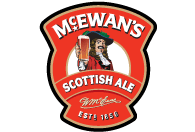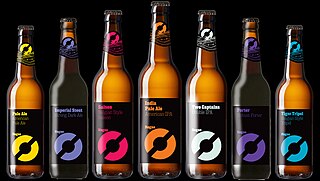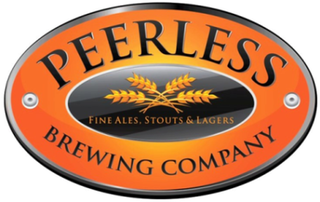
Pale ale is a golden to amber coloured beer style brewed with pale malt. The term first appeared in England around 1703 for beers made from malts dried with high-carbon coke, which resulted in a lighter colour than other beers popular at that time. Different brewing practices and hop quantities have resulted in a range of tastes and strengths within the pale ale family.

Pale lager is a pale-to-golden lager beer with a well-attenuated body and a varying degree of noble hop bitterness.

Old ale is a form of strong ale. The term is commonly applied to dark, malty beers in England, generally above 5% ABV, and also to dark ales of any strength in Australia. It is sometimes associated with stock ale or, archaically, keeping ale, in which the beer is held at the brewery. In modern times, the line has blurred between Old Ale and Barley wine.

Brown ale is a style of beer with a dark amber or brown colour. The term was first used by London brewers in the late 17th century to describe a lightly hopped ale brewed from 100% brown malt.

India pale ale (IPA) is a hoppy beer style within the broader category of pale ale.

Bass Brewery was founded in 1777 by William Bass in Burton-upon-Trent, Staffordshire, England. The main brand was Bass Pale Ale, once the highest-selling beer in the UK. By 1877, Bass had become the largest brewery in the world, with an annual output of one million barrels. Its pale ale was exported throughout the British Empire, and the company's red triangle became the UK's first registered trade mark.

Greene King is a British pub and brewing company founded in 1799, currently based in Bury St Edmunds, Suffolk. The company also owns brands including Hungry Horse and Farmhouse Inns, as well other pubs, restaurants and hotels. It was listed on the London Stock Exchange (LSE), until it was acquired by CK Assets in October 2019.

McEwan's is a brand of beer owned by Carlsberg Marston's Brewing Company. It was originally brewed by William McEwan's Fountain Brewery in Edinburgh, Scotland. The McEwan's brand passed to Heineken in 2008 after their purchase of Scottish & Newcastle's British operations. Heineken sold the brand to Wells & Young's in 2011, who sold their brewing operation, including the McEwan brand to Marston's in 2017. Cans and bottles are now brewed in Bedford, England.

Fuller's Brewery in Chiswick, west London, England, is the former brewing division of Fuller, Smith & Turner PLC. It was a family-run business from its foundation in 1845 until 2019, when it was sold to the Japanese international beverage giant Asahi.

Beer has been brewed in England for thousands of years. As a beer brewing country, it is known for top fermented cask beer which finishes maturing in the cellar of the pub rather than at the brewery and is served with only natural carbonation.

Nøgne Ø is a Norwegian brewery founded in January 2002 by Gunnar Wiig and Kjetil Jikiun. The name is Norwegian for "Naked Isle" and was selected from the 19th-century Norwegian poem Terje Vigen by Henrik Ibsen. In most years since 2006, the brewery has been on RateBeer's list of top 100 breweries in the world.

The beer market in Denmark is dominated by the brands Carlsberg and Tuborg. Since Tuborg was acquired by Carlsberg in 1970, Carlsberg has held a near-monopoly. A number of regional breweries, however, managed to survive, and most of them merged into Royal Unibrew in 2005. As of 2020, Ratebeer lists over 300 active breweries in Denmark, most of which are microbreweries.

Old Speckled Hen is a bitter beer made by the Morland Brewery, now owned by Greene King Brewery. Old Speckled Hen was first brewed in 1979 in Abingdon-on-Thames, Oxfordshire in England, to commemorate the 50th anniversary of the MG car factory there on 30 November 1979. Since 2000, when Greene King bought Morland and closed down the Abingdon brewery, it has been made in Greene King's Bury St Edmunds brewery. It is available in more than twenty different countries in bottles, cans and on tap from cask and keg. The brand has been expanded to include Old Crafty Hen, a 6.5% ABV ale, Hens Tooth, a 6.5% ABV ale, Old Golden Hen, a golden coloured 4.1% beer, and Old Hoppy Hen, a 4.2% ABV pale ale.

Oriental Brewery or OB is a South Korean brewery currently owned by AB InBev, and initially founded by Doosan Group.
Heineken N.V. is a Dutch brewer which owns a worldwide portfolio of over 170 beer brands, mainly pale lager, though some other beer styles are produced. The two largest brands are Heineken and Tecate; though the portfolio includes Amstel, Fosters, Sagres, Cruzcampo, Skopsko, Affligem, Żywiec, Starobrno, Zagorka, Zlatý Bažant, Laško and Birra Moretti.

The Malt Shovel Brewery is an Australian brewery owned by Lion, a subsidiary of the Japanese conglomerate Kirin. It is located in Camperdown, New South Wales. Malt Shovel is best known for its James Squire range of beers. The beer is named after the convict turned Australia's first brewer James Squire, who also went on to grow Australia's first hops and is said to have created Australia's first commercial brewery.
Dundee was a Rochester, New York–based brewing company that produced ales and lagers. It was part of the Genesee Brewing Company, owned by North American Breweries which started marketing the brand's first lager in 1994 as J.W. Dundee's Honey Brown. Honey Brown quickly gained a good reputation and won awards, most notably the gold medal at the 2004 World Beer Cup.

Peerless Brewing Company is an independent microbrewery based in Birkenhead on the Wirral Peninsula, producing cask brewed beers by combining traditional techniques and fine ingredients with a modern tang.
Worthington's White Shield was an India pale ale (IPA) available principally in bottle conditioned form.

Burton ale is a type of strong ale which is dark and sweet. It is named after the brewing town of Burton-on-Trent.






















